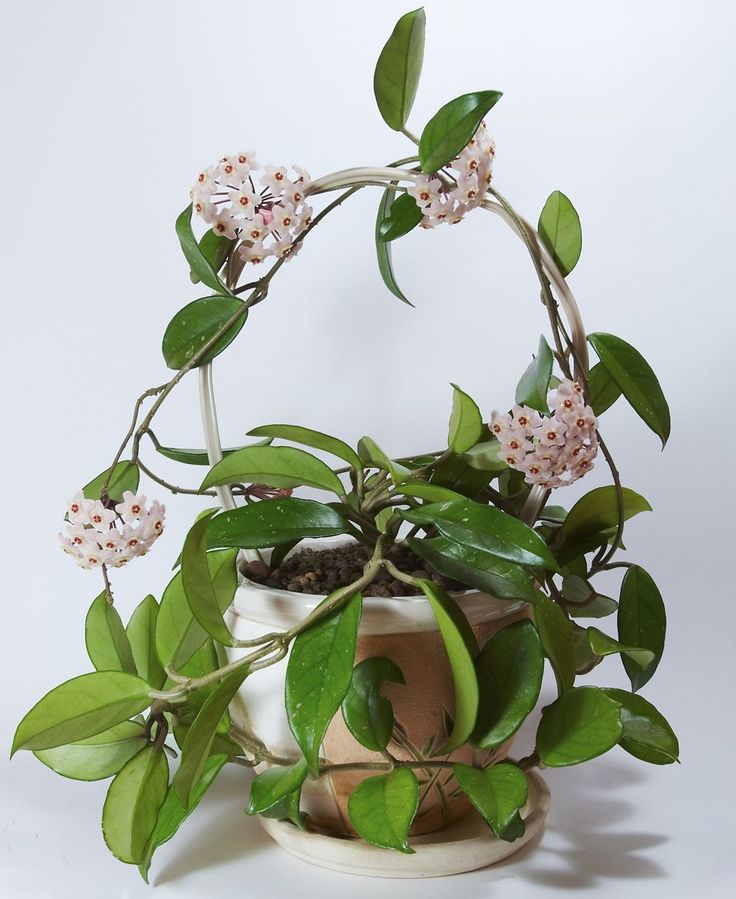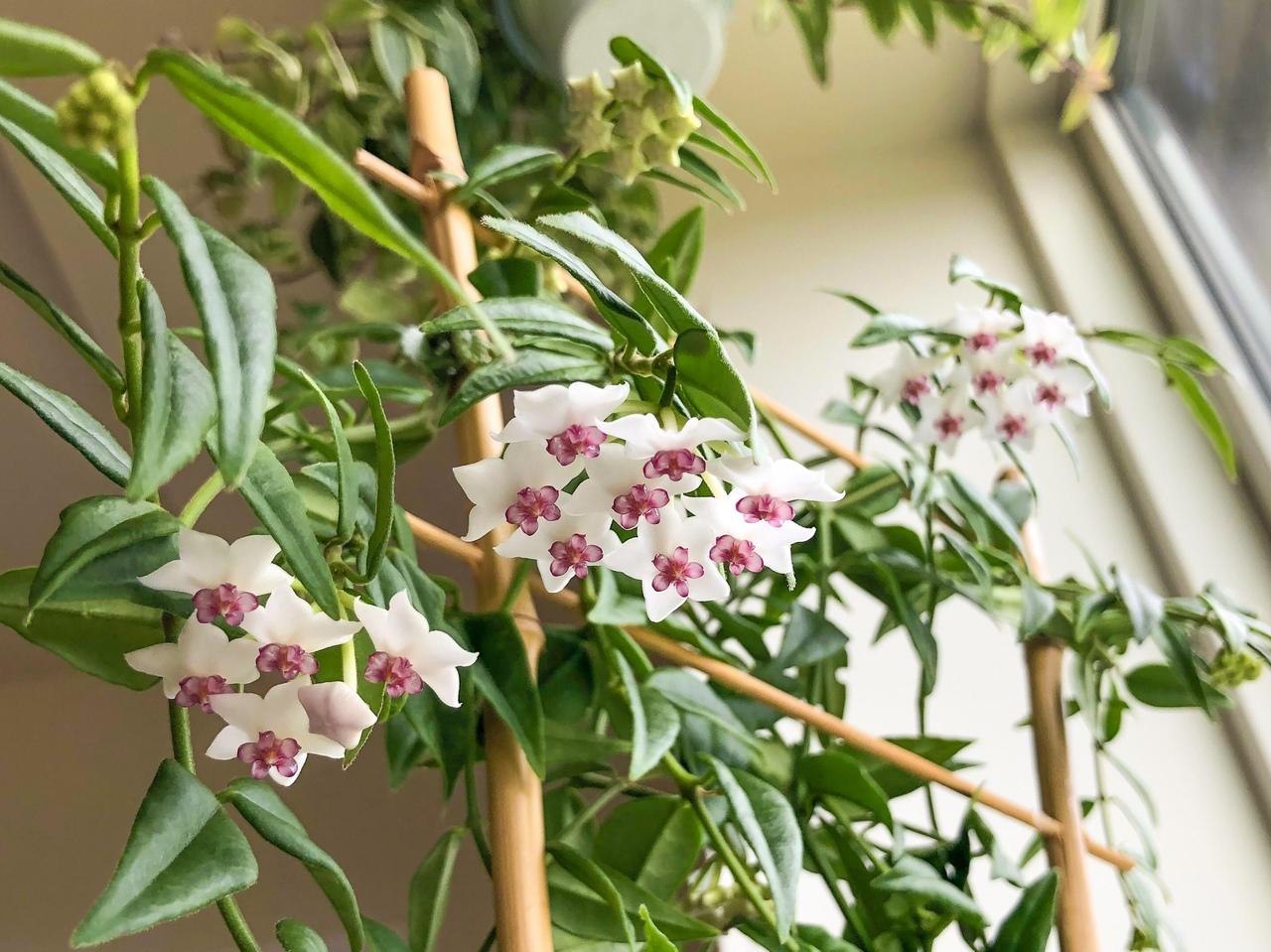As a passionate home gardener, I’ve always been captivated by the Hoya Bella, also known as Hoya lanceolata. This delightful member of the milkweed family is often admired for its unique qualities. Commonly referred to as the wax plant, wax flower, or honey plant, it’s a true gem with its charming, star-shaped flowers and vining growth habit. Let me walk you through a comprehensive guide that I’ve put together, which will help you understand and care for your Hoya Bella, ensuring it thrives in your home.

Distinctive Features and Fascinating Facts
- Ornamental Flowers: Hoya Bella is renowned for its beautiful, star-shaped white flowers with pink or red centers, which exude a sweet fragrance. The flowers have a waxy appearance, hence the nickname “wax flower.”
- Growth Form: It exhibits a shrubby, climbing, or trailing growth pattern, making it versatile for various display methods in home decor.
- Leaf Structure: The leaves are small, lance-shaped, and appear in pairs along the vine. They are a rich green, sometimes with lighter variegation.
- Epiphytic Nature: In its natural habitat, Hoya Bella grows on other plants or trees but is not parasitic. It absorbs nutrients and moisture from the air and rain.
Optimal Growing Conditions
- Light Requirements: The Hoya Bella thrives in bright, indirect sunlight. I find that a spot near an east or west-facing window works best. Direct sunlight can scorch its leaves, while insufficient light can hinder blooming.
- Watering Routine: This plant prefers to be watered when the topsoil begins to dry out. Overwatering can lead to root rot, so ensuring good drainage is essential.
Temperature and Humidity Preferences
- Temperature: Hoya Bella enjoys warm temperatures, ideally between 60°F and 80°F (15°C to 27°C). It should be protected from cold drafts and sudden temperature changes.
- Humidity: Being a tropical plant, it prefers high humidity. I use a humidifier or place the plant on a pebble tray to maintain the humidity levels it enjoys.
Soil and Fertilization
- Soil: A well-draining potting mix is crucial. I use a mix designed for orchids or cacti, or create my own mix with regular potting soil, perlite, and orchid bark.
- Fertilizing: I feed my Hoya Bella during the growing season (spring and summer) with a balanced, water-soluble fertilizer, diluted to half strength. In the dormant winter months, I reduce feeding.
Support and Training
- Support Structure: Providing a trellis or a small totem pole can support its climbing habit. Alternatively, it can be grown in a hanging basket where its vines can beautifully cascade down.
Pruning and Maintenance
- Pruning: Light pruning can encourage fuller growth. However, it’s important not to prune off the long tendrils where flowers develop, as Hoyas bloom from the same spurs year after year.
- Leaf Care: To keep the leaves glossy and healthy, I wipe them gently with a damp cloth to remove dust.
Propagation Techniques
- Propagating Hoya Bella: It’s easily propagated through stem cuttings. I take cuttings with a few leaf nodes and root them in water or soil.
Pest Management
- Common Pests: Keep an eye out for pests like mealybugs and aphids. Treat any infestations with insecticidal soap or neem oil.
Toxicity Information
- Safety Precautions: Hoya Bella is non-toxic to pets and humans, making it a safe choice for households with animals and children.
Decorative and Aesthetic Uses
- Interior Design Integration: Its cascading vines and showy flowers make Hoya Bella a stunning addition to any interior decor, especially suited for hanging baskets or as a shelf plant.
| Pros | Cons |
|---|---|
| Attractive Flowers 🌸 | Sensitive to Overwatering 💧 |
| Hoya Bella blooms with beautiful, fragrant star-shaped flowers, adding an aesthetic appeal to your indoor space. | Overwatering can lead to root rot. It requires well-draining soil and careful watering. |
| Low Maintenance 🛠️ | Light Sensitivity ☀️ |
| This plant is relatively easy to care for, making it suitable for beginners or those with a busy lifestyle. | Requires bright, indirect light to thrive and bloom. Direct sunlight can scorch its leaves. |
| Air Purifying 🌬️ | Slow Growing 🐌 |
| Hoya Bella contributes to a healthier indoor environment by purifying the air. | Growth and blooming can be slow, requiring patience and proper care to see results. |
| Pet-Friendly 🐾 | Climbing Support Needed 🌿 |
| Non-toxic to pets, making it a safe choice for households with animals. | Requires a trellis or support for optimal growth if allowed to climb. |
| Versatile in Placement 🏡 | High Humidity Preference 💧 |
| Can be placed in hanging baskets or trained to climb, offering flexibility in home decor. | Prefers high humidity, which might necessitate additional efforts in drier environments. |

FAQ
In my years of nurturing various houseplants, I’ve developed a special affinity for the Hoya lanceolata, commonly known as Bella Hoya. This plant, also referred to as the wax plant or honey plant, has a captivating charm. Let’s dive into some frequently asked questions about caring for this delightful plant.
How Do You Keep a Hoya Plant Happy?
Keeping Bella Hoya content involves a few key steps. Firstly, they love bright, indirect light. Secondly, it’s essential to use well-draining soil and ensure the pot has drainage holes. Watering should be moderate – allow the soil to dry out between waterings. Lastly, a stable environment without drastic temperature changes is ideal for their growth.
How Do You Care for Bella Hoya?
Caring for Bella Hoya involves ensuring adequate light, correct watering, and appropriate humidity. Place it in a spot where it receives bright, indirect sunlight. Water it when the top inch of soil feels dry, and ensure good drainage to prevent root rot. They also appreciate a bit of humidity, so a pebble tray or occasional misting can be beneficial.
Do Hoyas Prefer to Climb or Hang?
Hoyas, including Bella Hoya, are versatile in their growth habits. They naturally tend to climb, thanks to their vining nature. However, they also adapt beautifully to hanging baskets, where their cascading vines can be showcased elegantly. So, whether you let them climb a trellis or hang them up, they’ll adapt and grow beautifully.
How Do I Get My Hoya Bella to Bloom?
Encouraging Bella Hoya to bloom involves providing optimal conditions. They need plenty of bright, indirect light and a period of drier conditions in the winter. Avoid moving them frequently, as they prefer to stay in one place. Also, be cautious with pruning – the flowers bloom on spurs that grow back each year.
Is Hoya Bella an Indoor Plant?
Absolutely, Bella Hoya is an excellent indoor plant. It adapts well to indoor environments, particularly if you can provide bright, indirect light and stable temperatures. They’re perfect for adding a touch of nature’s beauty to your indoor spaces.
Do Hoyas Prefer to Grow Up or Down?
In my experience with Bella Hoyas, I’ve found that these plants naturally love to climb, yet they’re incredibly versatile. I can train them to trail downwards in hanging baskets just as easily. Due to their vining nature, I’ve styled them in various ways in my home. They look stunning trailing down from a shelf or gracefully climbing up a support. This adaptability lets me get creative with how I display them in different spaces.
Where is the Best Place to Hang a Hoya?
The best place to hang your Bella Hoya is near a window where it can receive bright, but indirect sunlight. Avoid direct sun exposure to prevent leaf burn. An east-facing window is ideal. Also, ensure the area isn’t prone to cold drafts or sudden temperature changes.
What is the Difference Between Hoya Paxtonii and Bella Hoya?
n my gardening adventures, I’ve noticed some key differences between Hoya paxtonii and Bella Hoya, though they both belong to the Hoya family. Firstly, Hoya paxtonii typically has larger and more elongated leaves, which is quite different from the smaller, more oval-shaped leaves of Bella Hoya. Furthermore, when it comes to flowers, Hoya paxtonii’s blossoms differ significantly in both structure and color from the charming star-shaped flowers of Bella Hoya. Understanding these distinctions really helps me appreciate the diversity within the Hoya family.
The Hoya Bella, with its delicate flowers and versatile growth habit, offers a blend of ornamental beauty and ease of care. It’s a perfect choice for those who love flowering plants but don’t want the hassle of high-maintenance care. With the right conditions, this charming plant can bring a touch of the tropics and a sweet fragrance to your home. 🌸🏡

